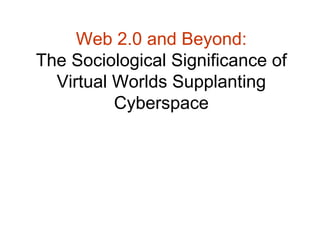James Witte - Opening Remarks
- 1. Web 2.0 and Beyond: The Sociological Significance of Virtual Worlds Supplanting Cyberspace
- 2. We have Tracy and Joanna to thank for our comfortable venue
- 3. Yes, we are in Second Life
- 4. Why do a Mini-Conference in SL Because we can Because the Hilton wanted lots of money to do it in one of their rooms Because many CITASA members may not have the travel funds or time to be in NYC today Because itŌĆÖs 2007 and this is the Internet Because CITASA members should know this technology and be comfortable with it
- 5. Thank you to other members of MC3.0 organizing committee Tracy Kennedy Anabel Quan Hasse Joanna Robinson
- 6. ╠²
- 7. Web2.0 and beyond What is Web2.0 , ask Tim OŌĆÖReilly views web as a platform not an application. harnesses collective intelligence . is data driven ; database management is a requisite core competency. brings an end to the software release cycle via continually updated web services Simple, light-weight programming is the goal. software created for multiple devices ; move from the PC is the default platform. end user experience a rich experience : a dynamic, multi-media experience.
- 8. Web2.0ŌĆ” is, explicitly, all about social computing. And beyond? ŌĆ£ You don't have to be a computer scientist to create a program. We are seeing that manifest in Web 2.0 and 3.0 will be a great extension of that, a true communal mediumŌĆ”the distinction between professional, semi-professional and consumers will get blurred, creating a network effect of business and applications.ŌĆØ Jerry Yang, Yahoo! co-founder
- 9. Session 1: Social Networking Sites Social Networking Sites: A Surveillance Studies Primer Dan Trottier QueenŌĆÖs University - Kingston, Ontario Exposed Edges And Tighter Nodes: A Suggested Social Networking Hypothesis For Web 2.0 as Seen Through a User Of Facebook Peter Timusk University of Ottawa - Ottawa, Ontario
- 10. Session 2: Videogames & Gaming WomenŌĆÖs Online Gaming Communities: DonŌĆÖt Hate the Game, Hate the Players Tracy Kennedy Communities & Technologies Research Group, Microsoft ŌĆō Redmond, Washington Disabilities and Gaming Environments Jeff Preston Western University - London, Ontario
- 11. Session 3: Virtual Worlds The Potential for Digital Field Assignments in Second Life Michael Reese Johns Hopkins University ŌĆō Baltimore, Maryland A Scanner Darkly: the death of authenticity under conditions of media-saturation Michael Roberts North Harris College ŌĆō Houston, Texas The Educators Coop Experience in Second Life Leslie Jarmon & Joe Sanchez The University of Texas - Austin, Texas
- 12. Session 3: Virtual Worlds Embodiment, Identity and Presence in Second Life ŌĆō New Wine or New Bottles? Geoffrey Edwards Canada Research Chair in Cognitive Geomatics - Universit├® Laval Participatory Pedagogy: Challenging ŌĆśReal LifeŌĆÖ: Practices of Educational Institutions in Virtual WorldsŌĆØ Joanna Robinson Great Northern Way Campus ŌĆō Vancouver, BC Tracy Kennedy Communities & Technologies Research Group Microsoft ŌĆō Redmond, Washington
- 13. Closing Remarks Sarah ŌĆ£IntellagirlŌĆØ Robbins Ball State University - Muncie, IN Afterwards, please feel free to continue the conversation in SL or Arrange an informal face-to-face conversation in NYC and Join us for a face-to-face discussion at the CITASA and Teaching and Learning in Sociology Joint Reception, Monday August 13, 6:30-8:30, at the Hilton New York, Sutton Parlor Center
Editor's Notes
- Welcome to Citasa Miniconference 3.0. ŌĆō MC3.0 In Prhiladeplhia, Montreal, and now New York City we have held a Miniconference as part of the ASAŌĆÖs annual meeting. Participation has grown each year ŌĆō and each year we have done something a little bit different. So whatŌĆÖs different this year?













